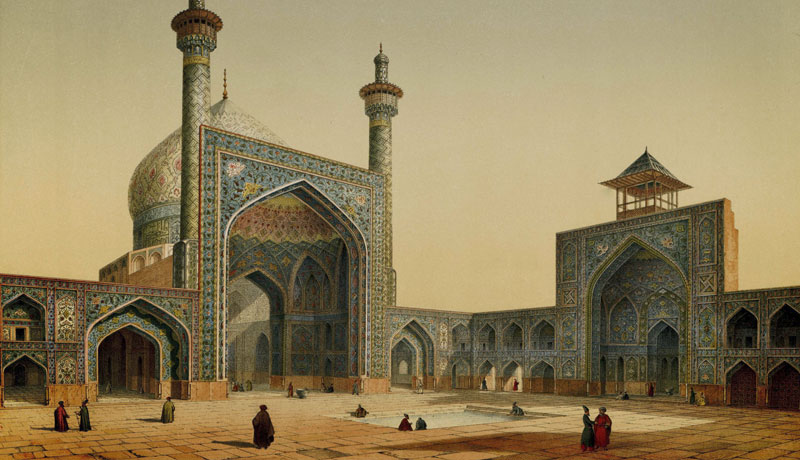Isfahan embodies the greatness of imperial Persia. In the early 16th century, the Safavid dynasty made Persia the homeland of the Shiite vision of Islam. In 1598 the Safavid Shah Abbas the Great moved his capital to Isfahan in the center of the country, and rebuilt the city with broad avenues, elaborate gardens, majestic bridges, a magnificent royal palace, and stunning mosques. Under this enlightened monarch, music, literature, and miniature painting flourished, and Isfahan became world-famous for the beauty of its carpets and textiles. His successors continued to build magnificent palaces, mosques, and schools. They established a flourishing tradition of support for the decorative arts, notably calligraphy and miniature painting. Isfahan’s era of glory lasted into the nineteenth century.
Friday, May 14
ISFAHAN IS HALF THE WORLD
Lecture Safavid Iran: Friend or Foe?
The newly established Safavid Shiite regime suffered birth pangs comparable to the adjustments of contemporary Europe to the culture of the Renaissance. The Safavids and European monarchs collaborated against the Ottoman empire which had already conquered large parts of Europe and threatened to expand eastward into Iran as well. Prize-winning historian Abbas Milani (Research Fellow, Hoover Institution, and Professor of Political Science, Stanford University) paints in deft, colorful strokes an image of Iranian society in this golden age and the role it played in international politics, focusing on the capital city of Isfahan as the perfect metaphor for the aspirations of Safavid royalty, particularly Shah Abbas.
Performance Dances from the Isfahan Region
Classical and folk dances from the Isfahan region performed by Ney Nava dance troupe, led by Shida Pegahi.
Saturday, May 15, 2004
JEWEL OF THE SAFAVIDS
Lecture The City of Isfahan and Its Glorious Architecture
“Isfahan nesf-e jahan” said the Safavids; “Isfahan is half the world,” and its architecture comes close to justifying this famous couplet. In moving the capital of Persia to Isfahan, Shah Abbas set out to create a glorious showplace of art, culture, and religion, to which travelers, ambassadors, and merchants from Europe and Asia would eagerly travel. Its beauty still remains as a center of exquisite art and architecture for the world to admire. Dr. Johanna Movassat (Lecturer in Art and Art History, San Jose State University), a popular lecturer on Asian architecture, is married to an Iranian and considers Isfahan her “second home.” Her lecture will include consideration of the key role of Shah Abbas in the planning of his imperial city.
Lecture Miniature Paintings of the Safavid Period
Miniature painters fostered by the Safavid court produced dazzling works of art that often broke new ground in their restricted genre. Isfahan’s artists, often using a single hair of the paintbrush, produced works of unsurpassed delicacy and detail, though simple in their themes and content: a princess bathing in a secluded stream; a king holding court. Carel Bertram (San Francisco State University) will analyze the aesthetics of Persian miniatures and explain their narrative function.
Performance Classical Iranian Music from the Isfahan-Shiraz Region
Performed by Mr. Mahmoud Zoufonoun and ensemble. Mr. Zoufonoun is probably the leading expert on classical Iranian music in the United States. His ensemble will play selected classical pieces and offer a demonstration of the authentic instruments on which they perform. Mr. Zoufonoun’s pupil, Professor Manuchehr Ghiassi of Santa Clara University, will discuss the function and structure of the music.
Lecture The Imagined Embrace: Christians and Jews Under the Safavids
The Safavid Dynasty proclaimed Twelver Shiite Islam as the state religion, and its rulers embarked on a rigorous campaign to convert muslims and non-muslims of Iran to Shiism. What was the status of religious minorities in Safavid Iran? How were Christians, Jews, Sunnis and Sufis treated? Did the state have an interest in favoring one against another? Professor Jaleh Pirnazar, (Near Eastern Studies Department, UC Berkeley) will address these questions through an examination of contemporary texts.
Lecture Carpets, Textiles and Other Applied Arts of the Safavids
Persian carpets are prized for their exquisite designs and colors, and carpets from Isfahan above all. But the Safavids excelled in metalwork, ceramics, and other areas of the applied arts as well. No one is better qualified to discuss the Safavid accomplishments in these fields than renowned art historian Walter B. Denny (University of Massachussets at Amherst), a dynamic lecturer and a consultant to numerous museums and private collectors.
Panel Discussion
All participants address audience questions.
Presenters
Carel Bertram, Humanities, San Francisco State University
Walter Denny, Art History, U Massachusetts Amherst
Abbas Milani, Political Sciences, Stanford
Johanna Movassat, Art History, San Jose State University
Jaleh Pirnazar, Persian Literature, UC Berkeley
